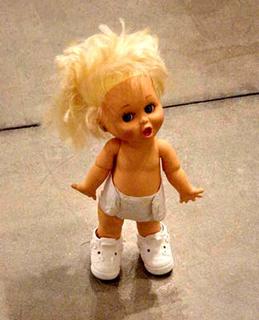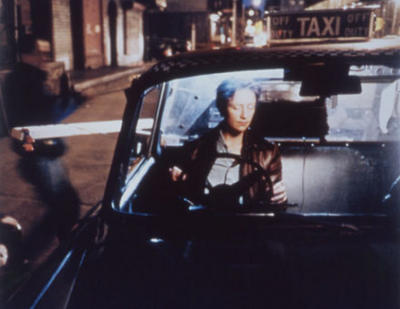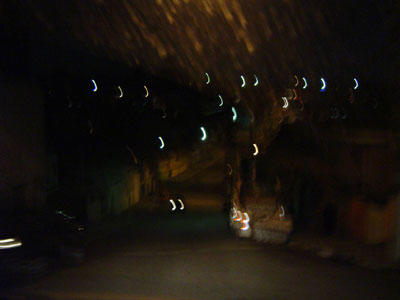
Zoe Leonard's recent installations and photographs, examining the time-worn objects that people leave behind, manage to evoke both nostalgia and resolve.
In her youth, the Victorian heroine of Peter Carey's 1988 novel Oscar and Lucinda appalls her frugal family by mutilating an expensive birthday doll. Despairing of her own frizzy mane, the nine-year-old Lucinda treats her toy as a surrogate self. She yanks out its curly blonde locks and artlessly affixes horsehair snippets that more closely resemble her parents' straight black tresses.
When in 1999 artist Zoe Leonard came upon such real-life playthings in tag sales and flea markets, she was struck by the physical evidence of wear and alterations which together were tantamount to autobiographies. These girlhood souvenirs pointed toward a psychosexual terrain worth surveying. Leonard ultimately amassed nearly 700 dolls in "played-with condition"--as the secondhand dealers described them--for use as raw material in her art. As an unintended by-product of these transactions, she accumulated a quantity of cast-off suitcases used to carry home her purchases.
It was after she remembered the dignified terra-cotta warriors of Xian, China, entombed for millennia in a stop-action march, that she understood how to utilize her growing stockpile of toys. For Mouth open, teeth showing, the principal installation in her recent show at Paula Cooper Galley in New York, Leonard stood 162 dolls at stately intervals, approximately 3 1/2 feet apart in a loose grid. Visitors entering Cooper's airy truss-roofed gallery could wade into a shallow sea of miniature women and girls, along with life-sized newborns, all as individual as the children who once owned them. The dolls with movable limbs has been coaxed into a walking stride, arms gently swinging. The generous distance between the rows allowed viewers to explore. A calm "personal space" encircled each winsome belle and eerily silent infant in the spooky Toyland army.
The phrase "mouth open, teeth showing," is doll collectors' parlance for valued feature of the early models made with smiling faces. Leonard liked the physicality of the words, which implied both passivity and aggression, encompassing the mixture of vulnerability and menace presented by a vast roomful of pint-sized people. Leonard initially titled the work Citizen and thought of it as a sociological reflection of female participation in the world. She found that her 75 Barbies were not suitable for inclusion because they literally couldn't stand on their own two feet. As she lived with her collection in her studio, the layered implications of working with human surrogates opened up to her.
Like Bernd and Hilla Becher's photographic series of closely related structures, Leonard's ranks of dolls invited the eye to discover the differences among them. No two were identical. Even when produced by the same manufacturer, each was subjected to unique alternations. The criteria for comparison expanded as one looked. A few were brandnew; others were bitten, broken or soiled. They were attired, undressed or partially clad. Several wore endearingly personalized getups, such as a tatted cape and matching tam-o'-shanter. Hair was another arena for individuation: their unruly coiffures frequently revealed the intervention of scissors, paint or girl-sized barrettes. Each figure was a richly contradictory repository of inaccessible memories along with socially decodable content.
The assembly spanned nearly a century, the earliest an antique composition doll ca. 1910 (the term refers to a wood pulp material that is cast in molds and then painted), the latest one still available in shops. Leonard offered such formal polarities as garish and subdued or big and little, and hinted at subtle narratives. A circumspect older girl in pajamas held her position next to a jubilant black cherub decked out as an in-line skater. A perky infant, head cocked as if listening, adjoined an armless, sooty-faced child with downcast eyes. Leonard's telling placements hinted at the diverse experiences of girlhood, with its potential for both joy and abuse. One ludicrous doll decked out in a purple flowered dress arrested attention. Holding her ground on chunky, Stakhanovite legs, she defiantly displayed a bald pate rising above a multitude of platinum plaits.
Leonard's grounded congregation staked a claim of kinship with Carl Andre's floor-based grids.(1) Viewers might also perceive consanguinity with Mike Kelley's floor installations of grimy stuffed animals and handmade toys. Closer to the present, Leonard's stripped and partially dressed dollies recall the live, wigged mannequins who constitute Vanessa Beecroft's sculptural modules. Indeed, Mouth open, teeth showing bears a stronger resemblance to Beecroft's staged performances of ambiguously vacuous young women than it does to the work of either Laurie Simmons or Ellen Phelan, for example, who have employed dolls in photographs and paintings. But unlike Beecroft's idlers, Leonard's marchers bespeak the artist's feminist intentions by suggesting group solidarity and a capacity for action.
Leonard created a second, untitled sculpture opposite the gallery's reception desk by stacking 77 suitcases against the wall in seven irregular piles. Like the participants in a police lineup, these frontal towers of slightly differing heights impassively awaited the scrutiny of visitors passing through the transitional space of the foyer. Arranged more for shape and color than by graduated size, the columns occasionally mimicked figurative curves. The palette leaned toward cool, tasteful hues, with sky blue predominating. Here again, the artist selected a range of vintage examples. Some, bearing brand names such as Amelia Earhart, Travel Joy and Shy Flite, were artifacts from an era when you dressed up to travel.
All found objects, particularly luggage, give off a lost quality. Many of the cases were personalized with monograms and scuffed by wear. Like the dolls once conveyed inside them, they no longer belonged to the people who had used them. Although visually ungendered, the suitcases were, as are all containers, readable as female biological metaphors. Variations in shape, surfaces and fastenings offered clues about their histories. Some handles--for example the sleek, molded-plastic ones of the '60s--are linked to specific moments in the history of design. Several cases conjured up cinematic images: the smart little tote stolen from runaway Claudette Colbert in It Happened One Night (1934) or the substantial baggage encumbering a married George Segal trysting with Glenda Jackson in A Touch of Class (1973). Darker allusions to the assembled property of Holocaust victims came to mind as well.
Leonard's thematic subtext of lost and found carried through into the final section of the exhibition, a selection of 10 new dye-transfer photographs hung in the front gallery. This series of found still lifes, or "organized remains," in the artist's description,(2) was harvested from sites and shop windows on New York's Lower East Side. Like Leonard's earlier black-and-white works, they form part of a larger, ongoing project that she regards as an urban archive of the handmade world. Part social anthropologist and part material culture expert, Leonard consistently gravitates toward the literal and symbolic signs of life that people leave behind.
With deadpan humor, she shot Sunshine Hotel in a flophouse, its name proclaimed by besmeared ceramic tiles mounted on a scarred red wall. Hand-lettered signage predominates in the photographs of glass-fronted stores: a pinked-edged yellow oval brashly asserts the availability of cold beer; a butcher perplexingly proclaims equal stocks of "goats, lamb, veal, breast"; adjacent to its graffiti-adorned siding, a seedy laundromat mournfully informs passersby of its hours and services. The two hand-me-down chairs loitering outside this enterprise might be the homeless relatives of the pompous upholstered pair smugly waiting inside a showroom in another print from this series.
A sense of quietude emanates from these artfully simple unpeopled views. Some show us figural stand-ins--for example, two orderly pairs of used shoes on makeshift mats, or a tailor's dignified dummy wearing a half-constructed jacket. Leonard's compositional strategy of "getting rid of surrounding noise" eliminates all that might compete with her visual target. In all of the work in this show, we are left with an intensely focused image that speaks in a soft, clear voice about what it is like to be human.
(1.) Leonard's previous installation Strange Fruit (1995) was also floor-based. It comprised strewn orange, apple and banana skins that had been laboriously reassembled and stitched. Like Antaeus, the Giant son of Mother Earth in Greek myth, all of Leonard's floor installations derive a special strength from a literal connection to the ground.
(2.) All quotes are from a telephone conversation with the author, Nov. 9, 2000.
Zoe Leonard's installations were on view at Paula Cooper Gallery, New York [Oct.21-Nov. 25, 2000]. New works will be shown at Gisela Capitain, Cologne [March], Anthony Meier, San Francisco [April], and Raffaella Cortese, Milan [September]. In addition, Mouth open, teeth showing will be on view at Wesleyan University, Middletown, Conn., in August and September.
Judith Stein, an independent curator and critic, is writing a biography of the late art dealer Richard Bellamy.
COPYRIGHT 2001 Brant Publications, Inc.
COPYRIGHT 2001 Gale Group
fonte: Find Articles.com









